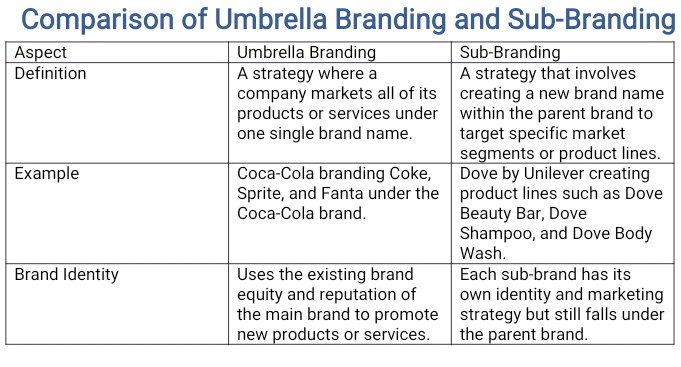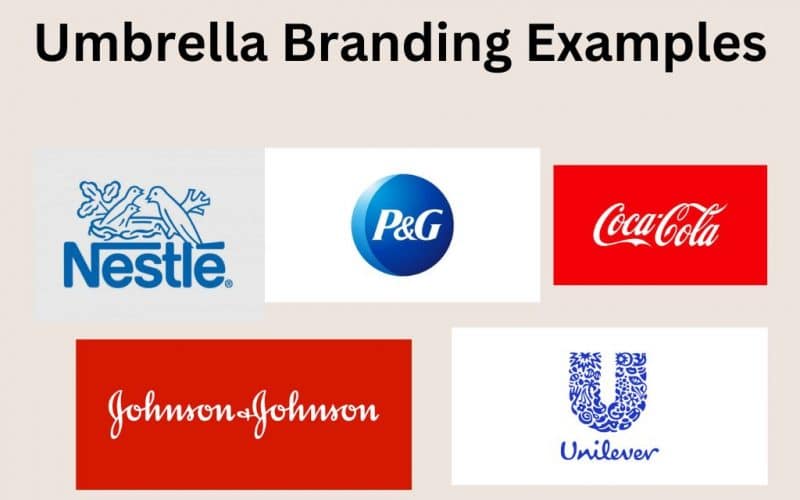Imagine walking into a bustling supermarket, your eyes darting from one product to another, trying to decide what to buy. Suddenly, a familiar logo catches your attention—It’s like they have this magical touch that makes everything they offer instantly recognizable and trusted by consumers. Well, that magic is called umbrella branding, also known as family branding.
And let me tell you, understanding the secrets behind successful examples and key strategies of umbrella branding can boost your business. So, keep reading to know how umbrella branding can attract and retain customers like never before.
Key Points
- Umbrella branding involves marketing multiple products under a single brand name to build a strong, unified brand image.
- Companies like Nestlé, Procter & Gamble (P&G), Johnson & Johnson, Unilever, and The Coca-Cola Company are well-known examples of firms using umbrella branding effectively.
- This system is cost-effective, using one marketing strategy across products and leveraging the parent brand’s established reputation.
- A disadvantage is that a single product’s failure can negatively impact the entire brand’s reputation.
- Notwithstanding, successful umbrella branding balances a consistent brand message while highlighting each product’s unique benefits to attract different customer segments.
Umbrella Branding
Umbrella branding, also known as family branding, is a marketing strategy where a company uses a single brand name for multiple related products or services. Like a big family where all the members share the same last name – that’s basically how umbrella branding works.
In this approach, the parent brand helps to create strong brand recognition and association among customers. For example, a company like Samsung makes numerous products including smartphones, TVs, and home appliances. By using the Samsung brand for all its products, the company benefits from the reputation and trust built around the Samsung name.
Umbrella branding is advantageous as it saves marketing costs by promoting all products under one brand umbrella. Also, it helps in leveraging the brand equity and goodwill of the parent brand across different product lines. However, one downside is that if one product under the umbrella brand faces a crisis or negative publicity, it can impact the reputation of all other products sharing the same brand name.
Umbrella Branding Example
Numerous companies fall under umbrella branding. Yeah! You might have come across them not knowing. Well, here are some umbrella branding examples
#1. Nestlé
Nestlé has something for everyone, right? I mean you can get a delicious chocolate bar, brew a cup of their rich coffee, whip up a quick meal for your little one with their baby food, and even take care of your furry friend with their pet care products. It’s like they’ve got it all covered!
And what I love is that no matter what Nestlé product you pick up, you can always trust in the quality they deliver. That iconic Nestlé logo is like a seal of approval. That’s letting you know that you’re getting something that’s been crafted with care and expertise. It’s all about that feeling of reassurance, knowing that you’re choosing a brand that’s been around for generations and has earned its reputation for excellence.
So, next time you’re browsing and spot that familiar Nestlé logo, just know you’re not just getting a product, you’re getting a promise of quality and trust. And that’s something that can make all the difference in your daily choices.
#2. Procter & Gamble (P&G)
Procter & Gamble, also known as P&G, is like the maestro of umbrella branding. It’s like they’ve got this giant umbrella, and under it, you’ll find big names like Crest for your pearly whites, Gillette for that clean shave, and Tide to keep your clothes looking fresh and clean. It’s pretty cool how all these brands, each serving a different need, are all part of the P&G family.
What I find impressive about P&G is their dedication to innovation and reliability. They’re not just about selling products; they’re about creating trust with their customers. You know that when you buy a P&G product, whether it’s toothpaste or laundry detergent, you’re getting quality and effectiveness.
#3. Johnson & Johnson
Johnson & Johnson is a household name that covers many products, from baby shampoo to pharmaceuticals and medical devices. Have you ever noticed how all these products fall under the same brand umbrella? This is called umbrella branding, and it’s a smart strategy that Johnson & Johnson uses to build consumer loyalty and promote brand recognition.
For instance, when you see the trusted Johnson & Johnson logo on a baby product, you automatically associate it with quality and safety. This positive connection extends to their other products as well, whether it’s a pain reliever or a medical device. By maintaining a consistent brand image across all their offerings, Johnson & Johnson makes it easier for consumers to trust and choose their products.
This approach not only helps in establishing brand loyalty but also saves resources on marketing campaigns for each product category. So, when consumers already have a positive perception of the brand, it becomes easier for new products to gain acceptance in the market.
#4. Unilever
Unilever is another giant in the consumer goods industry that practices umbrella branding. Instead of just focusing on one brand, they have multiple brands under their umbrella, like Dove for personal care, Lipton for beverages, and Hellmann’s for condiments.
What’s interesting is how Unilever manages to keep a consistent brand identity while offering numerous products. Like, you trust Dove for its gentle care products, Lipton for a refreshing drink, and Hellmann’s for that perfect touch to your sandwiches.
It’s pretty smart, right? By having these well-known brands, they can cater to different consumer needs while still being recognizable as part of the Unilever family. It’s like they have something for everyone, but you still know it’s all coming from the same trusted company.
#5. The Coca-Cola Company
Coca-Cola is a classic example of umbrella branding with a portfolio of beverages. I mean from the classic Coke and zesty Sprite to the pure Dasani water and flavorful Minute Maid juices, they’ve got it all under the Coca-Cola umbrella. That’s a one-stop shop for all your beverage needs!
One thing I like about this approach is that by sticking with the Coca-Cola brand across different drink categories, they make sure that you, me, and everyone else out there instantly think of taste and refreshment when we see that familiar logo. It’s all about creating that strong connection with the consumer.
So, I must say that next time you get a Coke or a Minute Maid juice, take a moment to appreciate how Coca-Cola has mastered the art of umbrella branding to keep us coming back for more. Also, try to copy their marketing strategy into your business.
What Is An Example Of Umbrella Branding?
A great example of this is the brand Coca-Cola. They have a range of products like Coca-Cola Classic, Diet Coke, Coca-Cola Zero, and Sprite. And all these fall under the Coca-Cola brand. Guess what? It helps to build brand recognition and loyalty among consumers.
This is because they trust the main brand and are more likely to try other products under the same umbrella. Therefore, see it as a family where each member has a unique personality but is connected by the same last name. Interesting, isn’t it?
What Is The Difference Between Umbrella Brand And Family Brand?
I know the umbrella brand and family brand might be confusing you but don’t worry, I’ll explain everything to you.
An umbrella brand is like a big parent company that houses multiple smaller brands under its name. Just like how a big umbrella covers and protects everything underneath it. A good example of an umbrella brand is Procter & Gamble, they own different brands like Tide, Pampers, and Gillette. These individual brands have their own identity but are all linked to the parent company, Procter & Gamble.
On the other hand, a family brand is when different products or services are grouped under one main brand name. It’s like a family where everyone shares the same last name. For instance, Toyota is a family brand that offers various types of vehicles. This includes sedans, SUVs, and trucks all under the main brand name Toyota.
So, the main difference is that under an umbrella brand, there are separate and distinct brands, while under a family brand, all products or services are united under one main brand name.
Also read these articles: Branding Like a Boss: How to Make Your Brand Unforgettable
Branding vs Positioning: Understanding the Difference
Is Coca Cola Umbrella Branding?
Yes, Coca-Cola is a great example of umbrella branding. Imagine strolling through a grocery store aisle and seeing all the different types of Coca-Cola products – from classic Coca-Cola to Diet Coke, Sprite, Fanta, and more. Despite each product having its unique flavor and branding, they all fall under the Coca-Cola umbrella.
Just like a big family tree, where Coca-Cola is the “parent” brand and the other products are its “children.” With the Coca-Cola name and logo on all these different beverages, the company creates a strong brand association and loyalty among consumers. So, when you see that iconic red and white logo, just know you’re getting a quality beverage that you can trust.
What Are The Disadvantages Of Umbrella Branding?
One major disadvantage is that if one product under the umbrella brand experiences a failure or controversy, it can tarnish the entire brand’s reputation. For example, if a clothing company faces a scandal due to unethical labor practices in one of its factories, all products under its umbrella brand may face a backlash from customers.
Another drawback is the lack of differentiation between products. When all products are marketed under the same brand name, it may be challenging for consumers to distinguish between them and understand their unique features or benefits. Then, this can lead to confusion and dissatisfaction among customers.
Additionally, if the umbrella brand is associated with a specific niche or target market, it may limit the company’s ability to introduce new products that appeal to different demographics. For instance, if a high-end luxury brand decides to launch a more affordable line of products, consumers may be hesitant to try it. Yeah! This is due to preconceived notions about the brand’s exclusivity.
Here’s a quick checklist to help you implement a successful umbrella branding strategy and avoid mistakes!
Key Strategies for Successful Umbrella Branding
What Is The Difference Between Umbrella Branding And Sub Branding?
Umbrella branding and sub-branding are both strategies that companies use to market their products or services under a certain brand. They both aim to create a strong brand identity and recognition in the minds of consumers, but they do it in slightly different ways.
With umbrella branding, also known as family branding, a company markets all of its products or services under one single brand name. For example, Coca-Cola sells different beverages like Coke, Sprite, and Fanta, all under the Coca-Cola brand. This approach uses the existing brand equity and reputation of the main brand to promote new products or services.
On the other hand, sub-branding involves creating a new brand name within the parent brand to target a specific market segment or product line. Take, for example, the brand Dove by Unilever. Dove has multiple product lines such as Dove Beauty Bar, Dove Shampoo, and Dove Body Wash. Each product line has its own brand identity and marketing strategy, but they all fall under the parent brand of Dove.

To sum it up, umbrella branding is about grouping various products or services under one overarching brand, while sub-branding involves creating separate brand identities for different products or services within the same company. Both strategies have their advantages and are used by companies depending on their marketing objectives and target audience.
Related Articles
How To Do Rebranding Campaign Effectively: Expert Ideas!!
Branding vs. Packaging: Key Strategies for Standing Out in Nigeria’s Market
Branding vs. Marketing: Examples and Differences






